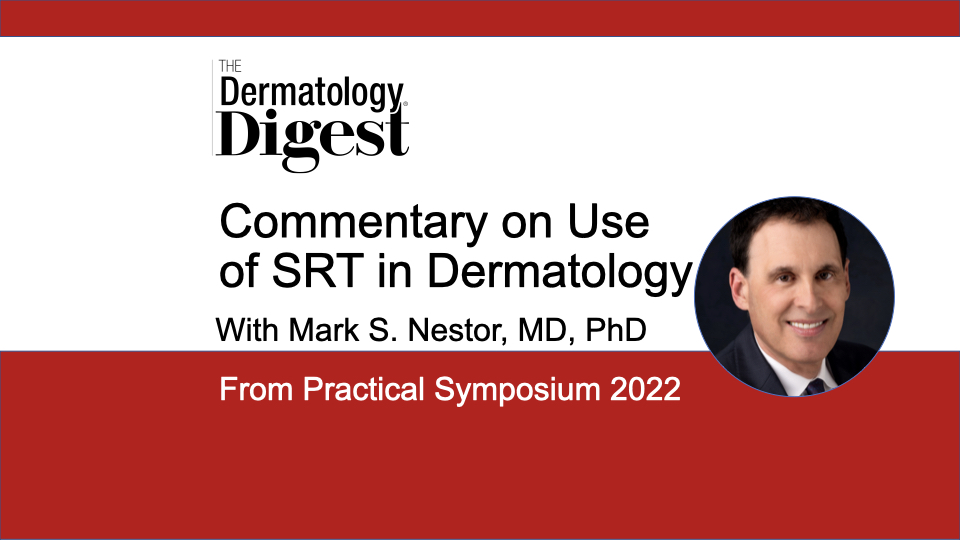Dr. Mark Nestor discusses the evolution of superficial radiation therapy (SRT) to treat nonmelanoma skin cancer, including a comparison with electron beam radiation therapy.
Mark S. Nestor, MD, PhD, is Director, Center for Cosmetic Enhancement, Aventura, and Voluntary Professor, Dermatology and Cutaneous Surgery, at the University of Miami Miller School of Medicine, Miami, Florida
“Nonmelanoma skin cancer is treated in a number of different ways by dermatologists. Certainly, surgery has been and continues to be one of the key ways of treating nonmelanoma skin cancer—be it regular excision, destruction, or Mohs micrographic surgery,” said Mark S. Nestor, MD, PhD, who presented “Use of SRT in Dermatology” during the Practical Symposium 2022 in Beaver Creek, Colorado.
“All of these are surgical procedures to treat … squamous cell carcinoma in situ, squamous cell carcinoma, and basal cell carcinoma, which are the most common but there are certainly other nonmelanoma skin cancers.”
Superficial radiation therapy (SRT) was among the main treatment options that dermatologists used through the mid-1970s, according to Dr. Nestor.
“In fact, a dermatologist invented radiation therapy to treat skin cancer well over 100 years ago. When I trained at NYU in the late ‘80s, early ‘90s, we were trained on superficial radiation therapy.”
But dermatologists’ use of superficial radiation therapy faded after the 1970s. SRT devices were hard to acquire and maintain, so more dermatologists performed Mohs micrographic surgery, and radiation oncologists used electron beam radiation therapy.
However, SRT has experienced a resurgence in dermatology over the past 12 years with the development of a more sophisticated and computerized SRT technology, which is what dermatologists use today, said Dr. Nestor.
SRT vs. Electron Beam
Both radiation therapies, there are key differences between electron beam therapy used by radiation oncologists and the latest SRT technology, which uses x-rays, said Dr. Nestor.
“One big difference is the cure rate for electron beam versus superficial [radiation therapy] is lower.”
The second difference is that the electron beam profile is less consistent.
“The penumbra, a drop off for electron beam, is about 6 mm, versus less than 1 mm for superficial radiation therapy. That’s very important because it means for electron beams you need much larger margins than you do with superficial radiation therapy because the beam is much more consistent.”
There have been numerous studies on SRT’s efficacy with nonmelanoma skin cancer—basal and squamous cell carcinomas. Essentially, the studies show there is at least equivalency to surgery for cure rates of superficial radiation therapy and many feel that the cosmesis is better with SRT, said Dr. Nestor.
“The latest studies using the most recent computerized equipment [Sensus Healthcare’s SRT-100] shows up to 98% long-term cure rate for basal and squamous cell carcinoma, including similar rates on the lower extremities. So, the data is very clear that there is significant efficacy. Patients seem to very much appreciate this, certainly for some skin cancers. And this is utilized across the country now by many individuals.”
The more recent addition of image-guided radiation therapy, which uses ultrasound to pinpoint a skin cancer’s depth, as well the overall area that the cancer is affecting, allows SRT users to target the energy more specifically from the radiation therapy to get a potentially better result long-term, according to Dr. Nestor.
“Radiation therapy also works for keloid scars, where it dramatically reduces surgical recurrence rates.”
“In my practice, I primarily use superficial radiation therapy on individuals with tumors on the scalp, on the nose, as well as on the lower extremities. We certainly do treat other areas as well, but those are the primary areas because we have such great results, including low incidence of infection.”
Patients are generally treated with 12 to 15 fractions, he said.
“SRT is a covered procedure. In fact, in the last couple of years, the reimbursement rate has increased significantly for radiation therapy. We also have to use evaluation and management (E/M) codes when we evaluate the patient, as we’re treating them to make sure we can go onto the next treatment. All of this has helped significantly in terms of reimbursement.”
Dermatologists can perform SRT safely and effectively in the office, without the need of a radiation oncologist, said Dr. Nestor.
“The equipment does not make a large footprint. And [in most states] regulatory approvals are not difficult.”
SRT Candidates
“We tend to not treat aggressive cancers with SRT. If you have a poorly differentiated squamous cell carcinoma or certain types of basal cell carcinoma that are more aggressive in nature, we tend to suggest either Mohs surgery or electron beam with a radiation oncologist.”
According to Dr. Nestor, he primarily treats older nonmelanoma skin cancer patients with SRT, with exceptions.
“I’ve treated many younger individuals in their 30s and 40s with skin cancers on the nose and other areas where they don’t want surgery. They understand that we know the short-term and the medium-term effects on skin. We don’t see cancer popping up again. There can be skin changes long-term, but for the most part it’s much less noticeable than with a big surgical scar and flap.”
Disclosure: Dr. Nestor is a consultant for Sensus Healthcare.


